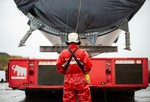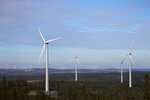11/04/2004
2005 is expected to be a record year for U.S. wind energy sector
With the extension of the federal wind energy production tax credit in September, capacity installations in 2005 look likely to beat all previous records, AWEA said in its quarterly U.S. market outlook. The previous high for new wind power capacity installations in one year was 1,696 MW in 2001. Most industry participants agree that 2005 will be a better year, with some predicting installations to exceed 2,500 MW. "Conditions are right for next year to be a record-breaking year," said AWEA executive director Randall Swisher.
The slow-down in installations in 2004 that resulted from the expiration of the production tax credit (PTC) means that many projects that have been in the development pipeline are now ready to move forward quickly. Wind power project developers and wind turbine and component manufacturers are now racing to lock up supply contracts for the coming year. At the same time, rising and volatile natural gas prices make wind energy attractive in terms of the long-term stable energy price that the technology can offer. Once a plant is built, it requires no fuel and produces no harmful emissions. The more wind energy capacity is installed, the more it will help to reduce the current natural gas supply shortage in the U.S., according to AWEA. The increasing use of natural gas to power electric generating plants is preventing the nation from building up its storage levels during the summer. But in many areas of the country where wind farms are generating electricity, they are directly helping to conserve vital natural gas supplies.
"We estimate that the wind farms already in place, and those that will be installed by the end of 2005, will be saving over 0.5 billion cubic feet (Bcf) of natural gas per day in 2006," said Swisher. "Using conservative growth estimates of 3,000 MW installed every two years for the next four years, the U.S. could top 15,000 MW of installed wind power capacity by the end of 2009, which would save nearly 0.9 Bcf/day by the end of this decade." Because the tax credit was extended relatively late in the year, AWEA expects the U.S. to install approximately 480 MW of new capacity in 2004, well above its previous estimate of 350 MW but far below previous strong years such as 2001 (1,696 MW) and 2003 (1,687 MW).
If installed wind power capacity were to consistently expand at a rate of 18% per year, AWEA said, six percent of the nation's electricity could be generated by wind power by the year 2020, resulting in over $100 billion of investment, in addition to saving millions of cubic feet of natural gas.
The slow-down in installations in 2004 that resulted from the expiration of the production tax credit (PTC) means that many projects that have been in the development pipeline are now ready to move forward quickly. Wind power project developers and wind turbine and component manufacturers are now racing to lock up supply contracts for the coming year. At the same time, rising and volatile natural gas prices make wind energy attractive in terms of the long-term stable energy price that the technology can offer. Once a plant is built, it requires no fuel and produces no harmful emissions. The more wind energy capacity is installed, the more it will help to reduce the current natural gas supply shortage in the U.S., according to AWEA. The increasing use of natural gas to power electric generating plants is preventing the nation from building up its storage levels during the summer. But in many areas of the country where wind farms are generating electricity, they are directly helping to conserve vital natural gas supplies.
"We estimate that the wind farms already in place, and those that will be installed by the end of 2005, will be saving over 0.5 billion cubic feet (Bcf) of natural gas per day in 2006," said Swisher. "Using conservative growth estimates of 3,000 MW installed every two years for the next four years, the U.S. could top 15,000 MW of installed wind power capacity by the end of 2009, which would save nearly 0.9 Bcf/day by the end of this decade." Because the tax credit was extended relatively late in the year, AWEA expects the U.S. to install approximately 480 MW of new capacity in 2004, well above its previous estimate of 350 MW but far below previous strong years such as 2001 (1,696 MW) and 2003 (1,687 MW).
If installed wind power capacity were to consistently expand at a rate of 18% per year, AWEA said, six percent of the nation's electricity could be generated by wind power by the year 2020, resulting in over $100 billion of investment, in addition to saving millions of cubic feet of natural gas.
- Source:
- AWEA
- Author:
- Edited by Trevor Sievert, Online Editorial Journalist
- Email:
- press@windfair.net
- Keywords:
- USA, AWEA, wind energy, wind turbine, wind power, onshore, offshore, wind farm







